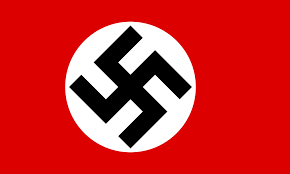Nazi flag Colors Code hex, png svg
The history of the Nazi flag, particularly the red, white, and black flag featuring a swastika, is tied deeply to the ideology and symbolism of the Nazi Party in Germany. Here’s a brief overview of its history and the meanings associated with its colors and symbols:
History
- Origins:
- The flag was adopted by the Nazi Party (National Socialist German Workers’ Party, NSDAP) in 1920.
- Designed by Adolf Hitler, who later wrote about its design in his book “Mein Kampf.”
- Design:
- The flag consists of a red background with a white circle in the center, which contains a black swastika rotated 45 degrees.
- The swastika, an ancient symbol, was repurposed by the Nazis as a representation of Aryan identity and racial purity.
- Adoption:
- The flag became the national flag of Germany after the Nazis came to power in 1933.
- It was used extensively as a symbol of the Third Reich until the end of World War II in 1945.
Colors and Symbolism
- Red:
- Represents the social idea of the Nazi movement, symbolizing the struggle and the revolution the party sought to bring about.
- It was meant to appeal to the working-class, as red was traditionally associated with socialism and communism.
- White:
- Signifies the nationalist idea, symbolizing purity and the Aryan race.
- It also represents the unity of the nation under the Nazi ideology.
- Black:
- The black swastika in the white circle was intended to be a symbol of the Aryan struggle.
- The swastika itself was chosen for its association with ancient Aryan culture and was meant to symbolize racial purity and the triumph of the Aryan race.
Symbol
- Swastika:
- An ancient symbol used in various cultures around the world for millennia, often representing luck, power, and life.
- The Nazis appropriated it, rotating it 45 degrees, to represent their ideology of Aryan racial supremacy.
Post-War Period
- After the defeat of Nazi Germany in 1945, the display and use of Nazi symbols, including the flag, were outlawed in Germany and many other countries.
- The flag remains a powerful symbol of hate and is banned in several countries due to its association with the atrocities of the Holocaust and World War II.
Legacy
- The Nazi flag’s association with the regime’s crimes against humanity ensures its legacy remains one of oppression and hate.
- It serves as a reminder of the destructive power of extremist ideologies and the importance of vigilance against such movements in contemporary society.
Guess the Flags Quiz
Sharing is caring 🤗

National Symbols 👇
- 🏁 National Flags
- 🦁 National Animals
- 🐦 National Birds
- 🌻 National Flowers
- 🌴 National Trees
- 🥭 National Fruits
- 🍹 National Drinks
- 👴 National Founders
- ☘️ National Emblems
- 🍲 National Dishes
- 🏛️ National Monuments
- ✍️ National Poets
- 🕌 National Mausoleums
- 🎺 National Instruments
- 🦸 National Heroes
- 📆 National Days

